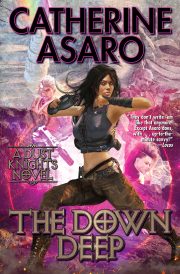Playtesting TTRPG Stories
by Austin Conrad
Editor’s note: This piece is part of our “Playtesting Game Narratives” series, curated by SFWA’s Game Writing Committee.
Tabletop role-playing games (TTRPGs) are built from basically two elements: game mechanics and narrative. Unlike video games, TTRPGs strongly focus on collaborative narrative between the players and the gamemaster at the table. Playtesting the narrative of a TTRPG diverges from other types of game writing due to the open-ended nature of the medium. Games such as Dungeons & Dragons or Call of Cthulhu don’t rely on the script of a video game or the clearly delineated rules of card games and board games. While TTRPGs do have rules and game mechanics—which also require testing—they fundamentally rely upon the players’ imagination in a way other game media do not.
This impacts TTRPG narratives because the player’s choices are open-ended. Possible responses to an in-game challenge are typically defined by each player’s imagination, not by the rules of the game. Consequently, playtests must be designed with those strengths in mind. This includes the intended plot of a particular work (such as an adventure the gamemaster runs for the players), as well as any narrative mechanics included in a core rulebook.
Set Playtesting Goals
Understand your goals and how to iterate your material through multiple rounds of testing to achieve them, similar to tweaking a novel after receiving feedback from beta readers. If you know your story’s intended emotional impact, you can make sensible revisions. Unlike a novel, a TTRPG’s narrative can change from one “read” to the next. Repeated playtests help the writer identify the variance in these outcomes and adjust their game’s design to strengthen the intended player experiences.
A common mistake is repeatedly playtesting TTRPG content by focusing on mechanics instead of narratives. While mechanics are undeniably important due to their structuring influence, failing to test the narrative can leave players dissatisfied and gamemasters unsure how to run your game.
Often, testing a TTRPG’s story takes time, especially for full campaigns of interconnected adventures (such as the famous Masks of Nyalarthotep). Because each session of a TTRPG can take multiple hours—and a full campaign can require 20 or more sessions to play—it’s not unusual for TTRPG narratives to undergo fewer playtests than narratives in other types of game writing. Setting goals for your playtest helps specify the round’s intended outcomes.
As in fiction, narrative playtesting goals should focus on the participants’ emotional experience of narrative elements. Don’t focus on whether or not a player “liked” the story. That’s not trivial, but it’s more important to ascertain if the game’s narrative is creating the expected emotions. For example, if an adventure’s ending is supposed to be sad but a playtest reports they liked the adventure’s happy ending, something has gone wrong. Focusing on intended experience prior to the playtester’s subjective opinion helps you understand if the game you’ve written functions as expected. If it doesn’t, then you have better information about how to revise the narrative and achieve the desired result.
Your goals should determine which material from your TTRPG is tested, what questions you ask the playtesters afterward, which playtesters you choose, and so on. Understanding how to ask questions connected to your goals is important. Frame these questions to encourage descriptive answers from the playtesters. For example, “What was your first thought when the mayor was killed?” is more likely to provide specific data about a player’s emotional response than “Did you find the mystery element intriguing or confusing?” Fortunately, the smaller sample size of TTRPG playtests means you’re less reliant on large-scale surveys and more able to analyze open-ended questions.
Don’t Help Playtesters
Give the material you’ve produced to a playtesting group without additional explanation or support. Effective game writing must stand without outside explanation.
A common error is supporting the players or gamemaster if they’re confused about how a narrative element should be presented or how some mechanics function. Observing playtests is a good source of data, but it’s best not to interfere directly. Watching someone get your game wrong is an important step in revising the text so that future customers will get it right.
Narrative Mechanics
Rules elements that blend “game physics” and narrative elements are increasingly popular in today’s TTRPGs. Mechanizing narratives in the game’s core rules strengthens role-play by providing incentives when players behave according to their character’s thoughts, feelings, and beliefs. Newer players feel supported when how to “play pretend” is more explicitly described. The player retains creative control—they typically choose their own character’s narrative parameters—but receives scaffolding within which to exercise it. As we know well, limitations foster creativity. For a classic example, Pendragon includes Traits and Passions for its medieval knights to describe their virtues and vices (such as “energetic” versus “lazy”). Players use their Traits to understand their character’s worldview. Rolls against these abilities allow players to overcome obstacles and influence the story—but may also result in melancholy or madness!
Narrative mechanics need to be playtested for their impact on both gameplay and on the group’s shared narrative. If a narrative mechanic doesn’t have a gameplay effect, it’s unlikely players will use it. Also, if it impacts gameplay but doesn’t impact the story, player immersion is reduced. The two aspects rely upon each other.
Fortunately, the narrative element of such mechanics can be tested like other story elements. Through questions and observation, the designer determines if the players are shaping the story through the use of mechanics or by some other means (such as a less rules-driven group consensus). In general, if a player feels the mechanics provide them with agency—helping them shape their story—then they are working effectively.
Conclusion
Playtesting helps game writers understand how narrative elements shape the player’s decisions and gameplay experience. Whether the core rulebook’s narrative mechanics or the story of an adventure, written narrative shapes—and is shaped by—player activity. Due to the open-ended structure of TTRPG stories, it’s not possible to account for everything the players might do. However, patient testing and revision enable designers to understand and respond to likely player choices. This helps players feel greater satisfaction because they have a say in the game’s narrative.
 Austin Conrad is a full-time writer and game designer best known for his indie RuneQuest publications. His work for other systems has been published by EN Publishing and Menagerie Press. Austin’s most recent release is “Treasures of Glorantha 2,” a compendium of magic items from an age of god-manipulating sorcerers and imperial dragons. You can learn more about Austin’s work on his website, akhelas.com.
Austin Conrad is a full-time writer and game designer best known for his indie RuneQuest publications. His work for other systems has been published by EN Publishing and Menagerie Press. Austin’s most recent release is “Treasures of Glorantha 2,” a compendium of magic items from an age of god-manipulating sorcerers and imperial dragons. You can learn more about Austin’s work on his website, akhelas.com.


